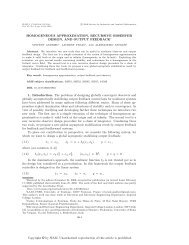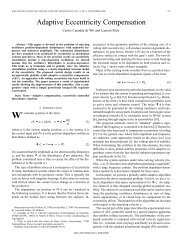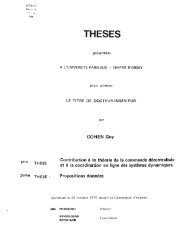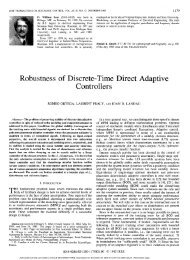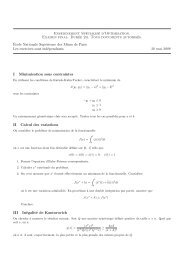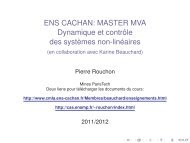Integrator Backstepping For Bounded Controls And Control Rates ...
Integrator Backstepping For Bounded Controls And Control Rates ...
Integrator Backstepping For Bounded Controls And Control Rates ...
You also want an ePaper? Increase the reach of your titles
YUMPU automatically turns print PDFs into web optimized ePapers that Google loves.
258 IEEE TRANSACTIONS ON AUTOMATIC CONTROL, VOL. 43, NO. 2, FEBRUARY 1998<br />
[17] Y. Yamamoto and P. Khargonekar, “Frequency response of sampleddata<br />
systems,” in Proc. 32nd Conf. Decision Contr., 1993, pp. 799–804;<br />
also IEEE Trans. Automat. Contr., vol. 39, pp. 166–176, 1996.<br />
[18] T. Hagiwara, Y. Ito, and M. Araki, “Computation of the frequency<br />
response gains and H1-norm of a sampled-data system,” Syst. Contr.<br />
Lett., vol. 25, pp. 281–288, 1995.<br />
[19] Y. Yamamoto and M. Araki, “Frequency responses for sampled-data<br />
systems—Their equivalence and relationships,” Linear Algebra Its Appl.,<br />
vol. 206, pp. 1319–1339, 1994.<br />
[20] T. Chen and B. Francis, Optimal Sampled-Data <strong>Control</strong> Systems. New<br />
York: Springer-Verlag, 1995.<br />
[21] M. Araki, Y. Ito, and T. Hagiwara, “Frequency response of sampleddata<br />
systems,” in Proc. 12th IFAC World Congr., 1993, pp. VII–289,<br />
1993; also Automatica, vol. 32, no. 4, pp. 483–497, 1996.<br />
[22] N. Sivashankar and P. Khargonekar, “Robust stability and performance<br />
analysis for sampled-data systems,” IEEE Trans. Automat. Contr., vol.<br />
39, pp. 58–69, 1993.<br />
[23] R. Middleton and J. Freudenberg, “Non-pathological sampling for<br />
generalized sampled-data hold functions,” Automatica, vol. 31, 1995.<br />
[24] R. Middleton and J. Xie, “Non-pathological sampling for high order<br />
generalized sampled-data hold functions,” in Proc. Automat. Contr.<br />
Conf., 1995.<br />
[25] T. Chen and B. Francis, “Input–output stability of sampled-data systems,”<br />
IEEE Trans. Automat. Contr., vol. 36, pp. 50–58, 1991.<br />
[26] B. Francis and T. Georgiou, “Stability theory for linear time-invariant<br />
plants with periodic digital controllers,” IEEE Trans. Automat. Contr.,<br />
vol. 33, pp. 820–832, 1988.<br />
[27] J. Braslavsky, G. Meinsma, R. Middleton, and J. Freudenberg, “On a key<br />
sampling formula relating the Laplace and Z-transforms,” Syst. Contr.<br />
Lett., vol. 29, pp. 181–190, 1997.<br />
[28] G. Goodwin and M. Salgado, “Frequency domain sensitivity functions<br />
for continuous time systems under sampled data control,” Automatica,<br />
vol. 30, p. 1263, 1994.<br />
[29] J. Freudenberg, R. Middleton, and J. Braslavsky, “Inherent design<br />
limitations for linear sampled-data feedback systems,” in Proc. Automat.<br />
Contr. Conf., June 1994, pp. 3227–3231; also Int. J. Contr., vol. 61, no.<br />
6, pp. 1387–1421, 1995.<br />
[30] R. Shenoy, D. Burnside, and T. Parks, “Linear periodic systems and<br />
multirate filter design,” IEEE Trans. Signal Process., vol. 42, pp.<br />
2242–2256, 1994.<br />
[31] A. Balakrishnan, Applied Functional Analysis. New York: Springer-<br />
Verlag, 1981.<br />
[32] T. Hagiwara and M. Araki, “Robust stability of sampled-data systems<br />
under possibly unstable additive/multiplicative perturbations,” in Proc.<br />
1995 Automat. Contr. Conf., 1995, pp. 3893–3898.<br />
[33] C. Van Loan, “Computing integrals involving the matrix exponential,”<br />
IEEE Trans. Automat. Contr., vol. 23, pp. 395–404, 1978.<br />
<strong>Integrator</strong> <strong>Backstepping</strong> for <strong>Bounded</strong><br />
<strong><strong>Control</strong>s</strong> and <strong>Control</strong> <strong>Rates</strong><br />
Randy Freeman and Laurent Praly<br />
Abstract— We present a backstepping procedure for the design of<br />
globally stabilizing state feedback control laws such that the magnitudes<br />
of the control signals and their derivatives are bounded by constants<br />
which do not depend on the initial conditions. We accomplish this<br />
by propagating such boundedness properties through each step of the<br />
recursive design.<br />
I. INTRODUCTION<br />
Recursive Lyapunov design procedures developed in recent years<br />
have expanded the classes of nonlinear systems for which systematic<br />
controller designs are possible. A prime example of such a procedure<br />
is integrator backstepping (see [2] and the references therein). The<br />
flexibilities of this procedure create opportunities for the improvement<br />
of performance and the satisfaction of design constraints.<br />
In this paper we present a new version of the backstepping<br />
procedure in which the boundedness of the control signal and its<br />
derivative are propagated through each step of the recursive design.<br />
We thereby add the powerful backstepping method to the collection of<br />
tools available for the global design of control systems with actuator<br />
constraints (see [4] and [7] for instance). The achieved bound on the<br />
control signal in our design cannot generally be made to satisfy an<br />
arbitrary prescribed constraint, unlike the bounds in the designs of<br />
[4] and [7]. However, our method applies to a much broader class<br />
of nonlinear systems, including those which do not admit controllers<br />
satisfying arbitrary constraints.<br />
The key feature of our method is a new choice for the Lyapunov<br />
function at each step of the recursive design, a choice based on<br />
combining design flexibilities proposed in [1] and [3]. We will give<br />
our main result in Section II, followed by its proof in Section III.<br />
II. BACKSTEPPING WITH ACTUATOR CONSTRAINTS<br />
A. Main Result<br />
Given continuous functions f; g: IR n !IR n and h: IR n 2IR !<br />
IR such that f (0) = 0 and h(0; 0) = 0, we consider the single-input<br />
system<br />
_x<br />
_y<br />
= F (x; y) +G(x; y)u (1)<br />
where (x; y) 2 IR n 2 IR is the state variable, u 2 IR is the control<br />
variable, and F and G are given by<br />
F (x; y) :=<br />
f(x)+g(x)y<br />
h(x; y)<br />
; G(x; y) := 0 1 : (2)<br />
Our goal in this paper is to present a set of conditions guaranteeing the<br />
existence of a stabilizing control law for (1) such that the magnitudes<br />
of both the control signal u and its derivative _u are bounded by<br />
a constant which does not depend on initial conditions. Roughly<br />
Manuscript received April 8, 1996; revised November 22, 1996.<br />
R. Freeman is with the Department of Electrical and Computer Engineering,<br />
Northwestern University, Evanston, IL 60208-3118 USA (e-mail:<br />
freeman@ece.nwu.edu).<br />
L. Praly is with CAS Ecole des Mines, 77305 Fontainebleau Cedex, France.<br />
Publisher Item Identifier S 0018-9286(98)00967-2.<br />
0018–9286/98$10.00 © 1998 IEEE
IEEE TRANSACTIONS ON AUTOMATIC CONTROL, VOL. 43, NO. 2, FEBRUARY 1998 259<br />
speaking, we will show that if the result already holds for the<br />
reduced-order system<br />
_x = f (x) +g(x)v (3)<br />
with some control law v = (x), then it does so for (1) with a control<br />
law u = (x; y). To be precise, we will prove the following.<br />
Theorem 1: Suppose there exist C 1 functions ; r; V; : IR n !<br />
IR such that<br />
A1) V , , and r are positive definite, V is proper, (0) = 0, and<br />
inf jxjc r(x) > 0 for some c>0;<br />
A2) jy 0 (x)j r(x)implies L f V (x)+L g V (x)y 0(x);<br />
A3) , r, L f , L g, L f r, L gr, and L gV are all bounded on IR n ;<br />
A4) L g V , L f , and (L g 1 ) are all O( (x)) as x ! 0;<br />
B1) there exists r 0 > 0 such that h is bounded on the set<br />
f(x; y) 2 IR n 2 IR : jy 0 (x)jr 0g;<br />
B2) there exists h 0 0 such that sign[y 0 (x)] 1 h(x; y) h 0<br />
on IR n 2 IR;<br />
B3) h is O( (x) +[y0(x)] 2 ) as (x; y) ! (0; 0).<br />
Then there exist C 1 functions ; ; U; : IR n 2IR ! IR such that<br />
C1) U, , are positive definite, U is proper, (0; 0) = 0, and<br />
inf f(x; y): jxj + jyj cg>0;<br />
C2) ju 0 (x; y)j (x; y) implies L F U (x; y) +<br />
L G U(x; y)u 0(x; y);<br />
C3) , , L F , L G, L F , L G, and L GU are all bounded on<br />
IR n 2 IR;<br />
C4) L G U, L F , and (L G 1 ) are all O( (x; y)) as (x; y) !<br />
(0; 0).<br />
B. Interpreting the Conclusion of Theorem 1: Properties C1)–C4)<br />
If we can satisfy A1)–A4) and B1)–B3), then this theorem generates<br />
a control law and a Lyapunov function U whose derivative<br />
along solutions of (1) with u = (x; y) satisfies, from C2)<br />
_U = L F U (x; y) +L G U(x; y) (x; y) 0(x; y): (4)<br />
Thus this control law globally asymptotically stabilizes the origin of<br />
(1), and we see from C3) that the control law u = (x; y) and its<br />
derivative<br />
_u(x; y) =L F(x; y) +L G(x; y)(x; y) (5)<br />
are bounded functions of (x; y) as desired. The control law used<br />
to prove Theorem 1 is simply<br />
(x; y) =0([y 0 (x)]) (6)<br />
where : IR ! IR is the C 1 saturation function defined in<br />
Section III-A. Following our proof, the constant design parameters<br />
and must be chosen sufficiently large. In general, there is no<br />
guarantee that the magnitude limit on the control law (6) can<br />
be chosen small enough to meet a prescribed constraint. A similar<br />
statement holds for the rate limit, which depends on both and <br />
as well as the functions f, g, h, , and .<br />
Theorem 1 can be applied recursively because properties C1)–C4)<br />
are to the complete system (1) as properties A1)–A4) are to the<br />
reduced-order system (3). After the first step in a recursive design, one<br />
needs only verify properties B1)–B3) at each new step. <strong>For</strong> example,<br />
by applying Theorem 1 twice, one can find constant parameters 1 ,<br />
1, 2, and 2 so that<br />
(x; y 1 ;y 2 )=0 2 2 y 2 + 1 1 y 1 + 2x2<br />
1+x 2 (7)<br />
is a magnitude- and rate-limited control law which globally asymptotically<br />
stabilizes the system<br />
_x =<br />
x3<br />
1+x 2 +xy 1<br />
_y 1 = y 2 0 x 2 maxf0; y 1g<br />
_y 2 =u+ sin (x 2 ):<br />
Furthermore, we immediately have the following corollary to Theorem<br />
1.<br />
Corollary 2: Let f; g: IR n !IR n be C 0 , and suppose there exist<br />
C 1 functions ; r; V; : IR n ! IR satisfying A1)–A4). Then for<br />
any m 1 there is a C 1 function : IR n 2 IR m ! IR such that<br />
the system<br />
_x = f (x)+g(x)y 1<br />
.<br />
_y i =y i+1 1 i m 0 1<br />
.<br />
_y m = (x; y)<br />
with y := [y 1 111 y m] T is globally asymptotically stable, and<br />
furthermore the control law u = (x; y) and its derivative _u(x; y)<br />
are bounded functions of (x; y).<br />
The control law in this corollary is given by<br />
(x; y) =0 m ( m [y m +111<br />
+ 2( 2[y 2 + 1( 1[y 1 0(x)])]) 111])<br />
(8)<br />
(9)<br />
(10)<br />
where the constants i and i are positive design parameters. It is<br />
reminiscent of the nested saturation control laws proposed in [5] and<br />
[6].<br />
C. Interpreting the Assumptions of Theorem 1:<br />
Properties A1)–A4) and B1)–B3)<br />
Assumptions A1)–A4) concern only the reduced-order system<br />
(3). Essentially, we require knowledge of a bounded function (x)<br />
such that with v = (x), this reduced-order system is globally<br />
asymptotically stable with Lyapunov function V (x). We require<br />
further that the functions L f and L g be bounded, which is<br />
tantamount to requiring that the control law , and its rate _ be<br />
bounded along solutions to (3). The function r is a measure of<br />
the stability robustness to errors in the implementation of for the<br />
reduced-order system (3). Because some amount of robustness will<br />
always exist, the only assumption concerning r is that it not vanish<br />
outside a neighborhood of x =0; the requirements that r, L f r, and<br />
L gr be bounded can be satisfied by taking r to be constant outside<br />
a compact set.<br />
In Condition A3), we require that the function L g V be bounded.<br />
This requirement is an important part of Theorem 1. Indeed, let us<br />
consider the n = 1system<br />
_x = 0x 3 + x 3 y; _y = u: (11)<br />
The feedback v = (x) 0 is bounded with bounded rate and<br />
globally asymptotically stabilizes<br />
_x = 0x 3 + x 3 v: (12)<br />
<strong>For</strong> r(x) 1 2<br />
, we see that conditions A1)–A4) hold, except that there<br />
is no proper C 1 function V (x) such that L gV (x) =V 0 (x)1x 3 is<br />
bounded. Therefore Theorem 1 does not apply, which is consistent
260 IEEE TRANSACTIONS ON AUTOMATIC CONTROL, VOL. 43, NO. 2, FEBRUARY 1998<br />
with the observation that no bounded control law u = (x; y) for<br />
(11) can prevent finite escape times from all initial conditions.<br />
The final requirement A4) on (3) is a mild condition on the local<br />
behavior of the functions V and in a neighborhood of x =0. This<br />
condition allows us to conclude the existence of a C 1 control law <br />
for (1) given a C 1 control law for (3). This is in contrast to standard<br />
backstepping results in which one degree of differentiability is lost,<br />
namely in which a C 1 control law yields a merely continuous<br />
(C 0 ) control law .<br />
Assumptions B1)–B3) concern only the function h in the y-<br />
subsystem of (1). Conditions B1) and B2) will always be satisfied<br />
when h is bounded, but they also allow h to be unbounded in certain<br />
directions. Condition B3) is a mild condition on the local behavior<br />
of the function h in a neighborhood of the point (x; y) =(0;0).<br />
III. PROOF OF THEOREM 1<br />
A. Definitions and Technical Preliminaries<br />
We will use the function K defined in [3, eq. (11)] as<br />
K(p; q) =<br />
q<br />
p<br />
[a(s0q)+b(sjsj0qjqj)] ds (13)<br />
= 1 2 a(p 0 q)2 + b( 1 3 jpj3 0 pqjqj + 2 3 jqj3 ) (14)<br />
where a>0and b>0are design parameters. One can verify that<br />
K(p; q) 0 for all p; q 2 IR, and furthermore K(p; q) =0if and<br />
only if p = q. Partial derivatives of the function K are<br />
K 1(p; q) := @K (p; q) =(p0q)M(p; q)<br />
@p<br />
(15)<br />
K 2 (p; q) := @K (p; q) =0(p0q)(a +2bjqj)<br />
@q<br />
(16)<br />
where M is the continuous function given by<br />
M (p; q) :=a+b1<br />
This function M satisfies the inequalities<br />
jpj+jqj; when pq 0<br />
p 2 + q 2<br />
jpj + jqj ; when pq < 0: (17)<br />
a + 1 b[jpj + jqj] M (p; q) a + b[jpj + jqj] (18)<br />
2<br />
for all p; q 2 IR. Also, given any compact set QIR, there exists<br />
! 0 such that<br />
K(p; q)<br />
lim<br />
= b jpj!1 jpj 3 3<br />
lim<br />
jpj!1<br />
jK 1(p; q)j<br />
p 2 = b;<br />
K 1(p; q)<br />
1+K(p; q) ! (19)<br />
for all p 2 IR and all q 2Q.<br />
We define a saturation function as follows. Given 0 > 1, let<br />
: IR![01;1] be C 1 , odd, nondecreasing, and such that with 0<br />
denoting the derivative of <br />
(s) = sign(s);<br />
s 2 s(s) 0s 2 ;<br />
0 0 (s) 0 ;<br />
when jsj 1<br />
when jsj 1<br />
8s2IR:<br />
We define C 1 functions + ; 0 :IR n<br />
!IR by<br />
(20)<br />
(21)<br />
(22)<br />
+ (x) :=(x)+r(x); 0 (x):=(x)0 r(x): (23)<br />
We use these functions to define the following sets in IR n 2 IR:<br />
A + := f(x; y) 2 IR n 2 IR : y> + (x)g (24)<br />
A 0 := f(x; y) 2 IR n 2 IR : 0 (x) y + (x)g (25)<br />
A 0 := f(x; y) 2 IR n 2 IR : y< 0 (x)g (26)<br />
A 6 := A + [ A 0 : (27)<br />
Note that IR n 2 IR = A + [ A 0 [ A 0 and that A + , A 0 , and A 0 are<br />
disjoint. In the following we shall typically write:<br />
0 I(x; y; 6 ); 8 (x; y) 2 A 6 (28)<br />
where I is some function. This must be understood as<br />
and<br />
0 I(x; y; + (x)); 8 (x; y) 2 A +<br />
0 I(x; y; 0 (x)); 8 (x; y) 2 A 0 : (29)<br />
Using this notation and letting R := sup x<br />
r(x), we have, for all<br />
(x; y) 2 A 6 0 < (y 0 6 (x))(y 0 (x)) jy0(x)j 2 (30)<br />
r(x) minfR; jy 0 (x)jg: (31)<br />
We note that the function<br />
(x; y) 7!<br />
j([y 0 (x)])j; when (x; y) 2 A6<br />
(r(x)); when (x; y) 2 A 0 (32)<br />
is continuous, positive definite, and bounded away from zero outside<br />
a compact neighborhood of (x; y) =(0;0).<br />
We assume, without loss of generality, that<br />
r; L f r; and (L gr 1 ) are all o( (x)) as x ! 0: (33)<br />
Indeed, if the given function r violates this condition, we can always<br />
flatten it near x =0while preserving A1)–A4) and B1)–B3) so that<br />
this condition is satisfied.<br />
With A1), we see that outside a compact neighborhood of x =0,<br />
r(x)can be used to bound any bounded function. From (31) the same<br />
holds on A 6 with jy 0 (x)j. Consequently, from A3), A4), (31),<br />
and (33) there exist nonnegative constants c 0 and c 1 such that for<br />
all (x; y) 2 A 6<br />
jL g V (x) 0 (a +2bj 6 (x)j)(L f 6 (x) +L g 6 (x) 6 (x))j<br />
c 1 (c 0 + a + b)[<br />
2<br />
(x) +jy0(x)j]: (34)<br />
3<br />
Similarly, it follows from (18), (31), B2), and B3) that there exists<br />
c 2 0 such that for all (x; y) 2 A 6 :<br />
M (y; 6 (x)) sign(y 0 6 (x))h(x; y)<br />
2<br />
c 2(a + b)[<br />
3 (x)+jy0(x)j]<br />
+c 2 M(y; 6 (x)) minfR; jy 0 (x)jg: (35)
IEEE TRANSACTIONS ON AUTOMATIC CONTROL, VOL. 43, NO. 2, FEBRUARY 1998 261<br />
By using (21) of , (18) on M, and by imposing<br />
1<br />
sup x<br />
fr(x)g = 1 R (36)<br />
we get the following inequalities:<br />
jy 0 (x)j 1)<br />
jy0(x)j 1 aj([y 0 (x)])j (37)<br />
a<br />
1 jy 0 (x)j )<br />
jy0(x)j(jyj+j 6 (x)j+r(x))<br />
1 1 j([y 0 (x)])j (38)<br />
<br />
max<br />
<br />
R a ; 2 b<br />
<br />
a + b(jyj + j6 (x)j)<br />
2<br />
1j([y 0 (x)])j: (39)<br />
This yields, for all (x; y)<br />
jy 0 (x)j 1 max R<br />
a ; 2 M (y; 6 (x))<br />
b<br />
1j([y 0 (x)])j: (40)<br />
Also, we have<br />
minfR; jy 0 (x)jg R minf1; jy0(x)jg<br />
R j([y 0 (x)])j: (41)<br />
<br />
B. Proof of Theorem 1<br />
1) Proof of Global Stability: We propose a Lyapunov function<br />
W (x; y) which belongs to the family of Lyapunov functions described<br />
in [3] and is “flattened” inside the set A 0 , as proposed in<br />
[1]<br />
W (x; y) :=V(x)+ K(y; 6 (x)); when (x; y) 2 A 6<br />
0; when (x; y) 2 A 0 (42)<br />
where K is given by (14). One can verify that W is C 1 , positive<br />
definite, and proper. We next compute W _ in each of the two sets<br />
A 6 and A 0 .<br />
In the set A 0 we obtain, using A2)<br />
_W (x; y) =L f V(x)+L g V(x)y0(x): (43)<br />
Therefore, _W (x; y) is negative definite on A 0 , regardless of the<br />
value of the control variable u.<br />
In the set A 6 we obtain, with u = (x; y) given by (6)<br />
_W (x; y) 0(x)+T(x; y) 0 [y 0 6 (x)]<br />
1 M (y; 6 (x))([y 0 (x)]) (44)<br />
where M is from (17) and<br />
T (x; y) =[y0 6 (x)][L g V (x) +M(y; 6 (x))h(x; y)<br />
0 (a +2bj 6 (x)j)(L f 6 (x) +L g 6 (x)y)]:<br />
It remains to determine the negativeness of _W (x; y) on the set A 6 .<br />
<strong>For</strong> this we observe that by completing the squares and using (30),<br />
(34), and (35), we get, for all (x; y) 2 A 6<br />
T (x; y) 1 3 (x) +jy06 (x)j<br />
1[(c 2 1(c 0 + a + b) 2 + c 0 c 1 + c 2 2(a + b) 2<br />
+(c 1 +c 2 +c 3)(a + b))jy 0 (x)j<br />
+ c 2 M (y; 6 (x)) minfR; jy 0 (x)jg] (45)<br />
where c 3 is given by the boundedness of L g 6 and 6 . Then, with<br />
(40) and (41), we get more simply<br />
T (x; y) 1 3 (x) +jy06 (x)jM(y; 6 (x)) 1j([y 0 (x)])j<br />
1 1 <br />
[c 2 1(c 0 + a + b) 2 + c 0 c 1<br />
+ c 2 2(a + b) 2 +(c 1 +c 2 +c 3 )(a + b)]<br />
1 max R a ; 2 + c 2R : (46)<br />
b<br />
So by imposing that be large enough, we finally arrive at<br />
_W (x; y) 0 2 (x)0 1jy06 (x)j<br />
3 2<br />
1M(y; 6 (x))j([y 0 (x)])j (47)<br />
for all (x; y) 2 A 6 . This proves the negative definiteness of W _ (x; y)<br />
on A 6 .<br />
2) Construction of the Function : With the properties of the<br />
function defined in (32), we can construct a C 1 positive definite<br />
function (x; y) such that<br />
(x; y) 1 j([y 0 (x)])j; when (x; y) 2 A6<br />
4<br />
1<br />
4 (r(x)); when (x; y) 2 (48)<br />
A0<br />
and furthermore is constant outside some compact set. With this<br />
choice for we obtain<br />
where<br />
S(x; y) =<br />
ju 0 (x; y)j (x; y) =) _ W 0S(x; y) (49)<br />
2<br />
3 (x)+ a jy06 (x)j<br />
4<br />
1j([y 0 (x)])j; when (x; y) 2 A 6 (50)<br />
(x); when (x; y) 2 A 0 .<br />
3) Construction of the Functions U and : We define U as<br />
U (x; y) := ln[1 + W (x; y)] (51)<br />
where W is given by (42). We now show that there exists a function<br />
(x; y) such that<br />
• is C 1 and positive definite;<br />
• for all (x; y) 2 IR n 2 IR<br />
S(x; y)<br />
(x; y) <br />
1+W(x; y) ; (52)<br />
• there exist CIR n 2 IR, a compact neighborhood of the origin,<br />
and a constant >0such that for all (x; y) 2C<br />
(x; y) [(x) +(y0(x)) 2 ]: (53)<br />
First, because s 2 s(s) when jsj 1, and (33) holds, there is some<br />
compact neighborhood C of the origin such that for all (x; y) 2C<br />
j([y 0 (x)])j jy 0 (x)j;<br />
1<br />
8 ar(x)2 1 3 (x):<br />
(54)<br />
Let us now bound S(x; y) from below. We begin by observing from<br />
(54) that on A 6 \C<br />
a<br />
4 jy06 (x)jj([y 0 (x)])j<br />
1 4 a[(y 0 (x))2 0 r(x)jy 0 (x)j] (55)<br />
1 4 a[ 1 2 (y 0 (x))2 0 1 2 r(x)2 ] (56)<br />
1 8 a(y 0 (x))2 0 1 3 (x): (57)<br />
Furthermore, because jy 0 (x)j r(x)on A 0 , we have from (54)<br />
that<br />
1<br />
3 (x) 1 8 a(y 0 (x))2 (58)
262 IEEE TRANSACTIONS ON AUTOMATIC CONTROL, VOL. 43, NO. 2, FEBRUARY 1998<br />
on A 0 \C. We conclude from (57) and (58) that for all (x; y) 2C<br />
S(x; y) 1 3 (x) + 1 8 a(y 0 (x))2 : (59)<br />
Therefore, the function having the properties listed above must<br />
indeed exist.<br />
4) Properties C1)–C4) are Satisfied:<br />
• Property C1) follows from the construction of , , U, and .<br />
• Property C2) follows from (49), (51), and (52).<br />
• The functions , L F , and L G are bounded because is<br />
constant outside a bounded set. By definition, is bounded on<br />
IR n 2 IR. We calculate L G and L F as follows:<br />
L G (x; y) =0 0 ([y 0 (x)]) (60)<br />
L F (x; y) = 0 ([y 0 (x)])<br />
1 [L f (x) +L g (x)y0h(x; y)]: (61)<br />
Recall that j 0 (s)j 0 for all s 2 IR; from this we conclude that<br />
L G is bounded on IR n 2 IR. On the other hand, if we require to<br />
be large enough to satisfy both (36) and<br />
1<br />
(62)<br />
r 0<br />
ACKNOWLEDGMENT<br />
The authors would like to thank P. Kokotović for his helpful<br />
comments.<br />
REFERENCES<br />
[1] R. A. Freeman and P. V. Kokotović, “Design of ‘softer’ robust nonlinear<br />
control laws,” Automatica, vol. 29, no. 6, pp. 1425–1437, 1993.<br />
[2] M. Krstić, I. Kanellakopoulos, and P. V. Kokotović, Nonlinear and<br />
Adaptive <strong>Control</strong> Design. New York: Wiley, 1995.<br />
[3] L. Praly, B. d’<strong>And</strong>réa Novel, and J.-M. Coron, “Lyapunov design of<br />
stabilizing controllers for cascaded systems,” IEEE Trans. Automat.<br />
Contr., vol. 36, pp. 1177–1181, Oct. 1991.<br />
[4] H. J. Sussmann, E. D. Sontag, and Y. Yang, “A general result on the<br />
stabilization of linear systems using bounded controls,” IEEE Trans.<br />
Automat. Contr., vol. 39, pp. 2411–2425, Dec. 1994.<br />
[5] A. R. Teel, “Using saturation to stabilize a class of single-input partially<br />
linear composite systems,” in Proc. IFAC Nonlinear Contr. Syst. Design<br />
Symp., Bordeaux, France, June 1992.<br />
[6] , “Feedback stabilization: Nonlinear solutions to inherently nonlinear<br />
problems,” Univ. California, Berkeley, CA, Tech. Rep. UCB/ERL<br />
M92/65, June 1992.<br />
[7] , “Global stabilization and restricted tracking for multiple integrators<br />
with bounded controls,” Syst. Contr. Lett., vol. 18, no. 3, pp.<br />
165–171, 1992.<br />
then, with B1), A3), and the fact that 0 (s) = 0for jsj 1,we<br />
see that the function<br />
0 ([y 0 (x)])[L g (x) y 0 h(x; y)]<br />
is bounded. We conclude from this and A3) that L F is bounded.<br />
We next verify that L G U is bounded on IR n 2 IR. It follows from<br />
(42) and (51) that<br />
1<br />
L GU (x; y) =<br />
1+V(x)+K(y; 6 (x))<br />
1<br />
K 1 (y; 6 (x)); when (x; y) 2 A 6<br />
0; when (x; y) 2 A 0 .<br />
(63)<br />
Since 6 is bounded, we conclude from (19) that L GU is bounded;<br />
thus C3) holds.<br />
• We have left to verify C4).<br />
1) From (6), (15), (30), and (63) we see that both <br />
and L G U are O([y 0 (x)]) as (x; y) ! (0; 0),<br />
and it follows from (53) that L GU and (L G 1 ) are<br />
O( (x; y)) as (x; y) ! (0; 0).<br />
2) From (61) we have<br />
jL F (x; y)j 0 [jL f (x)j + j(L g 1 )(x)j<br />
+ jL g (x)jjy0(x)j+jh(x; y)j]<br />
and it follows from A4), B3), and (53) that L F is<br />
O( (x; y)) as (x; y) ! (0; 0).<br />
IV. CONCLUDING REMARKS<br />
We have presented a new backstepping procedure for the design of<br />
state feedback control laws which are bounded both in magnitude and<br />
rate. Although the proposed Lyapunov function is necessarily more<br />
complicated than the standard Lyapunov function for backstepping,<br />
the resulting control law has a simple form.<br />
On the Computation of the Induced Norm of<br />
Single-Input Linear Systems with Saturation<br />
B. G. Romanchuk<br />
Abstract—In this paper, a means of determining an upper bound of the<br />
induced L 2 norm for a class of single-input linear systems with saturation<br />
is given in terms of the existence of a candidate function which satisfies<br />
three differential inequalities. A technique to calculate such a function<br />
for systems with linear controllers is also developed.<br />
Index Terms—Finite gain stability, nonlinear H1 control, saturating<br />
systems.<br />
I. INTRODUCTION<br />
The extension of H1 control methodologies to the robust control<br />
problem for nonlinear systems is a research topic which has recently<br />
attracted attention. One of the core analysis problems which needs to<br />
be addressed is the induced-norm computation problem, which must<br />
be solved before the synthesis problem can be seriously examined.<br />
Using the concept of dissipativity introduced by Willems in [12],<br />
there has been some effort on this topic for affine nonlinear systems,<br />
some recent papers on which are [6] and [11]. The class of systems<br />
examined in this paper are those with input constraints; recent related<br />
work includes [7] and [8].<br />
The development undertaken in this paper does not use any normbound<br />
assumptions to estimate away the effect of the memoryless<br />
nonlinearity, hence it is possible to undertake nonconservative analysis.<br />
This is also done in the paper [4], although for another problem<br />
Manuscript received July 9, 1994; revised July 11, 1995 and May 21, 1996.<br />
This research was supported in part by NSERC and EPSRC.<br />
The author is with McGill University, Montreal, PQ, H3A 2A7 Canada.<br />
Publisher Item Identifier S 0018-9286(98)00929-5.<br />
0018–9286/98$10.00 © 1998 IEEE



